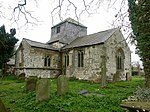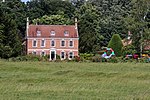Yarburgh
Civil parishes in LincolnshireEast Lindsey DistrictLincolnshire geography stubsUse British English from November 2014Villages in Lincolnshire

Yarburgh is a village and civil parish in the East Lindsey district of Lincolnshire, England, and situated approximately 4 miles (6 km) north-east from the town of Louth.The name 'Yarburgh' means 'fortification made of earth'.St John the Baptist's Church in Yarburgh dates from at least the 13th century, although it was rebuilt after a fire in 1405 and restored in 1855. It is now in the care of The Churches Conservation Trust.
Excerpt from the Wikipedia article Yarburgh (License: CC BY-SA 3.0, Authors, Images).Yarburgh
Yarburgh Road, East Lindsey
Geographical coordinates (GPS) Address Nearby Places Show on map
Geographical coordinates (GPS)
| Latitude | Longitude |
|---|---|
| N 53.41711 ° | E 0.02805 ° |
Address
Yarburgh Village Hall
Yarburgh Road
LN11 0QG East Lindsey
England, United Kingdom
Open on Google Maps









